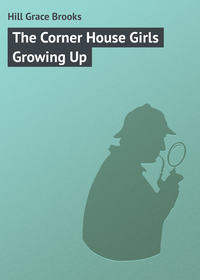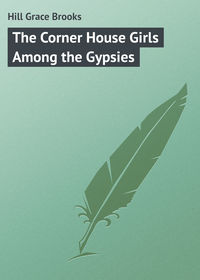 полная версия
полная версияThe Corner House Girls' Odd Find

Hill Grace Brooks
The Corner House Girls' Odd Find / Where they made it, and What the Strange Discovery led to
CHAPTER I – A FIND IN THE GARRET
The fireboard before the great chimney-place in the spacious dining room of the old Corner House in Milton had been removed by Uncle Rufus, and in the dusk of the winter’s afternoon the black pit of it yawned, ogre-like, upon the festive room.
The shadows were black under the big tree, the tip of which touched the very high ceiling and which had just been set up in the far corner and not yet festooned. The girls were all busy bringing tinsel and glittering balls and cheery red bells and strings of pink and white popcorn, while yards and yards of evergreen “rope,” with which to trim the room itself, were heaped in a corner.
It was the day but one before Christmas, and without the gaslight – or even the usual gas-log fire on the hearth – the dining room was gloomy even at mid-afternoon. Whenever Dot Kenway passed the black opening under the high and ornate mantel, she shuddered.
It was a creepy, delicious shudder that the smallest Corner House girl experienced, for she said to Tess, her confidant and the next oldest of the four sisters:
“Of course, I know it’s the only way Santa Claus ever comes. But – but I should think he’d be afraid of – of rats or things. I don’t see why he can’t come in at the door; it’d be more respecterful.”
“I s’pose you mean respectable,” sighed Tess. “But where would he hitch his reindeer? You know he has to tie them to the chimney on the roof.”
“Why does he?” demanded the inquisitive Dot. “There’s a perfectly good hitching post by our side gate on Willow Street.”
“Who ever heard of such a thing!” exclaimed Tess, with exasperation. “Do you s’pose Santa Claus would come to the side door and knock like the old clo’s man? You are the most ridiculous child, Dot Kenway,” concluded Tess, with her most grown-up air.
“Say,” said the quite unabashed Dot, reflectively, “do you know what Sammy Pinkney says?”
“Nothing very good, I am sure,” rejoined her sister, tartly, for just at this time Sammy Pinkney, almost their next-door neighbor, was very much in Tess Kenway’s bad books. “What can you expect of a boy who wants to be a pirate?”
“Well,” Dot proclaimed, “Sammy says he doesn’t believe there is such a person as Santa Claus.”
“Oh!” gasped Tess, startled by this heresy. Then, after reflection, she added: “Well, when you come to think of it, I don’t suppose there is any Santa for Sammy Pinkney.”
“Oh, Tess!” almost groaned the smaller girl.
“No, I don’t,” repeated Tess, with greater confidence. “Ruthie says if we don’t ‘really and truly’ believe in Santa, there isn’t any – for us! And he only comes to good children, anyway. How could you expect Sammy Pinkney to have a Santa Claus?”
“He says,” said Dot, eagerly, “that they are only make believe. Why, there is one in Blachstein & Mapes’, where Ruth trades; and another in Millikin’s; and there’s the Salvation Army Santa Clauses on the streets – ”
“Pooh!” exclaimed Tess, tossing her head. “They are only representations of Santa Claus. They’re men dressed up. Why! little boys have Santa Claus suits to play in, just as they have Indian suits and cowboy suits.”
“But – but is there really and truly a Santa Claus?” questioned Dot, in an awed tone. “And does he keep a book with your name in it? And if you don’t get too many black marks through the year do you get presents? And if you do behave too badly will he leave a whip, or something nasty, in your stocking? Say, Tess, do you s’pose ’tis so?”
That was a stiff one – even for Tess Kenway’s abounding faith. She was silent for a moment.
“Say! do you?” repeated the smallest Corner House girl.
“I tell you, Dot,” Tess said, finally, “I want to believe it. I just do. It’s like fairies and elfs. We want to believe in them, don’t we? It’s just like your Alice-doll being alive.”
“Well!” exclaimed Dot, stoutly, “she’s just as good as alive!”
“Of course she is, Dottie,” said Tess, eagerly. “And so’s Santa Claus. And – and when we stop believing in him, we won’t have near so much fun at Christmas!”
Just then Agnes came in from the kitchen with a heaping pan of warm popcorn.
“Here, you kiddies,” she cried, “run and get your needles and thread. We haven’t near enough popcorn strung. I believe Neale O’Neil ate more than he strung last night, I never did see such a hungry boy!”
“Mrs. MacCall say it’s ’cause he’s growning,” said Dot, solemnly.
“He, he!” chuckled Agnes. “He should be ‘groaning’ after all he gobbled down last night. And I burned my finger and roasted my face, popping it.”
She set down the dish of flaky white puff-balls on a stool, so it would be handy for the little girls. Both brought their sewing boxes and squatted down on the floor in the light from a long window. Tess was soon busily threading the popcorn.
“What’s the matter with you, Dot Kenway?” she demanded, as the smallest Corner House girl seemed still to be fussing with her thread and needle, her face puckered up and a frown on her small brow. “You’re the slowest thing!”
“I – I believe this needle’s asleep, Tess,” wailed Dot, finally.
“Asleep?” gasped the other. “What nonsense!”
“Yes, ’tis – so now!” ejaculated Dot. “Anyway, I can’t get its eye open.”
A low laugh sounded behind them, and a tall girl swooped down on the floor and put her arms around the smallest Corner House girl.
“Let sister do it for you, honeybee,” said the newcomer. “Won’t the eye open? Well! we’ll make it – there!”
This was Ruth, the oldest of the four Kenway sisters. She was dark, not particularly pretty, but, as Tess often said, awfully good! Ruth had a smile that illuminated her rather plain face and won her friends everywhere. Moreover, she had a beautiful, low, sweet voice – a “mother voice,” Agnes said.
Ruth had been mothering her three younger sisters for a long time now – ever since their real mother had died, leaving Agnes and Tess and Dot, to say nothing of Aunt Sarah Maltby, in the older girl’s care. And faithfully had Ruth Kenway performed her duty.
Agnes was the pretty sister (although Tess, with all her gravity, promised to equal the fly-away in time) for she had beautiful light hair, a rosy complexion, and large blue eyes, of an expression most innocent but in the depths of which lurked the Imps of Mischief.
Little Dot was dark, like Ruth; only she was most lovely – her hair wavy and silky, her little limbs round, her eyes bright, and her lips as red as an ox-heart cherry!
The little girls went on stringing the popcorn, and Ruth and Agnes began to trim the tree, commencing at the very top. Nestling among the pointed branches of the fir was a winged cupid, with bow and arrow.
“That’s so much better than a bell. Everybody has bells,” said Agnes, from the step-ladder, as she viewed the cupid with satisfaction.
“It’s an awfully cunning little fat, white baby,” agreed Dot, from the floor. “But I should be afraid, if I were his mother, to let him play with bows-an’-arrows. Maybe he’ll prick himself.”
“We’ll speak to Venus about that,” chuckled Agnes. “Don’t believe anybody ever mentioned it to her.”
“‘Venus’?” repeated Dot, gravely. “Why, that’s the name of the lady that lives next to Uncle Rufus’ Petunia. She couldn’t be that little baby’s mother for she’s – oh! —awful black!”
“Aggie was speaking of another Venus, Dot,” laughed Ruth. “Fasten those little candle-holders securely, Aggie.”
“Sure!” agreed the second, and slangy, sister.
“I really wish we could light the whole room with candles, and not have the gas at all,” Ruth said. “It would be much nicer. Don’t you think so?”
“It would be scrumptious!” Aggie cried. “And you’ve got such a lot of those nice, fat, bayberry candles. Let’s do it!”
“But there are not enough candlesticks.”
“You can get ’em at the five-and-ten-cent store,” proposed Tess, who favored that busy emporium, “because you can get such a lot for your money!”
“Goosey!” exclaimed Agnes. “We don’t want cheap ones. How would they look beside those lovely old silver ones of Uncle Peter Stower’s?” and she turned to look at the great candelabra on the highboy.
Just then the door from the butler’s pantry opened slowly and a grizzled, kinky head, with a shiny, brown, bald spot on top, was thrust into the room.
“I say, missie!” drawled the voice belonging to the ancient head, “is yo’ done seen anyt’ing ob dat denim bag I has fo’ de soiled napkins? Pechunia, she done comin’ fo’ de wash, an’ I got t’ collect togeddah all I kin fin’ dis week. Dat fool brack woman,” Uncle Rufus added with disgust, “won’t do but dis one wash twill happen New Years – naw’m! She jes’ got t’ cel’brate, she say. Ma’ soul! what’s a po’, miserble nigger woman got t’ cel’brate fo’ Ah asks ye?”
“Why, Uncle Rufus!” cried Agnes. “Christmas is a birthday that everybody ought to celebrate. And I’m sure Petunia has many things to make her happy.”
“Just look at all her children!” put in Tess.
“Alfredia, and Jackson Montgomery Simms, and little Burne-Jones Whistler and Louise Annette,” Dot began to intone, naming the roll of Petunia Blossom’s piccaninnies.
“Don’t! Stop!” begged Agnes, with her hands over her ears and sitting down on the top step of the ladder.
“Ma soul!” chuckled Uncle Rufus, “if chillens come lak’ Chris’mus presents, all de rich w’ite folks would hab ’em an’ de po’ nigger folks would be habbin’ wot de paper calls ‘race sooincide’ – sho’ would!”
“I haven’t seen the laundry bag, Unc’ Rufus,” said Ruth, deep in thought.
Here Dot spoke up. “I ‘spect I know where it is, Unc’ Rufus,” she said.
“Wal! I ‘spected some ob yo’ chillen done had it.”
“You know,” said Dot, seriously, “my Alice-doll is real weakly. The doctors don’t give me much ’couragement about her. Her lungs are weak – they have been, you know, ever since that awful Trouble girl buried her with the dried apples.”
“Dat Lillie Treble. Ah ‘members hit – sho!” chuckled Uncle Rufus, the Corner House girls’ chief factotum, who was a tall, thin, brown old negro, round shouldered with age, but “spry and pert,” as he said himself.
“And the doctors,” went on Dot, waxing serious, and her imagination “working over time,” as Neale O’Neil would have said, “say it’s best for folks with weak lungs to sleep out of doors. So Neale’s built her a sleeping porch outside one of the windows in our bedroom – Tess’ and mine – and – and I used your napkin bag, Unc’ Rufus, for a sleeping-bag for my Alice-doll! I couldn’t find anything else that fitted her,” confessed the smallest Corner House girl.
“Well! of all the children!” cried Agnes, having taken her hands down from her ears to hear this.
“You shouldn’t have taken the bag without permission,” Ruth gravely told Dot.
But Uncle Rufus chuckled over it to a great extent. “Nebber did see de beat of dese young-uns!” he gasped finally. “If yo’ Uncle Peter was alive he sartain sho’ would ha’ laffed hisself up out’n hes sick-bed. Ma soul an’ body! W’y didn’t he know enough t’ hab yo’uns yere in de ol’ Corner House w’ile he was alive, ‘stid o’ waitin’ till he was daid t’ gib it t’ yo’?”
He would have gone out chuckling, only Ruth called after him: “Unc’ Rufus! Do you know if there are any more candlesticks around the house? Nice, heavy ones, I mean – good enough to put in the dining room here, and for company to see.”
“Candlesticks, missie? I ’spect dere is,” said the old negro man.
“Do you know where?” Ruth asked quickly.
“Bress yo’, honey! I ‘speck dey is up in de attic,” he said. “I don’ jes’ know whar – ”
“Oh, I know! I know!” cried Agnes, suddenly. “Over in that corner of the garret that we never cleaned, Ruth.”
“Did we fail to clear up any part of the garret?” asked the older girl, doubtfully.
“The place Tommy Rooney hid in when he was the attic goat,” Dot said solemnly.
“Ghost!” admonished Tess. “I do wish you’d get your words right, Dot Kenway.”
“I remember seeing some old brass candlesticks there,” Agnes went on to explain to Ruth. “They can be polished, I should think. They’re all green now.”
“Of course,” said Ruth, cheerfully. “Let’s go and look for them.”
“Oh, I want to go!” cried Dot, at once.
“May we all go, sister?” asked Tess.
“Of course you may come, kiddies,” said Agnes, hopping down from her perch.
They all trooped up the three flights of stairs to the huge garret, Dot leaving her “sleeping” needle sticking in a puff-ball of popcorn.
The front hall of the old Corner House, as Milton folk called the Stower homestead on the corner of Willow Street, opposite the Parade Ground, was two stories high.
Broad stairs, dividing when half way up into two separate flights, rose out of the middle of the reception hall, lined with its old-fashioned, walnut, haircloth furniture. A gallery ran all around the stair-well, off which opened the guest chambers of the house. Only one of these was in use. Aunt Sarah Maltby had it. Aunt Sarah was determined to have the best there was of everything.
The girls slept in rooms in one of the two ells, on this second floor. Above, in the third story of the same ell, slept Mrs. MacCall, their good Scotch housekeeper, and Linda, the Finnish girl. Uncle Rufus was stowed away in the other ell, in a little room he had occupied for almost twenty-six years. Uncle Rufus had been Uncle Peter Stower’s only retainer for many, many years before the Kenway girls came to live at the old Corner House.
Up another flight of stairs, the girls trooped to the garret, that extended the entire length and breadth of the main portion of the house. This was their playroom on rainy days, and a storeroom of wonderful things. The Kenways had never entirely exhausted the wonders of this place.
Agnes led the way to the far corner, lamp in hand. There some Revolutionary uniforms hung from the low rafters. On a broken-legged chest of drawers, held up by a brick in place of the missing leg, stood a row of heavy brass candlesticks.
“And see here!” cried Agnes, snatching up a faded, fat, plush-covered volume, moth-eaten and shabby, from which Ruth had just removed two of the candlesticks. “What can this be? The family album, I declare!”
She flirted several of the leaves. Others stuck together. There seemed to be some kind of illustrations, or pictures, between the pages.
“Throw that dusty old thing down, Aggie,” said Ruth, “and help me carry these heavy candlesticks. They are just the things.”
“I’ll help carry them,” agreed her sister. “Here, Dottums. You can just about lug this old book. I want to look at it. I shouldn’t wonder if it held daguerreotypes and silhouettes of all the Stowers since Adam.”
“What are da – da-gert-o-tops and – and silly-hats, Aggie?” demanded Dot, toiling along at the end of the procession with the big book, as the four girls started down stairs again. “Are – are they those awful animals Ruth was reading about that used to in – infest the earth so long ago?”
“Oh, mercy me!” gasped Agnes, laughing. “Pterodactyls and the giant sloth! See what it means to tell these kids about the Paleozoic age and ‘sich,’ Ruthie! Yes, child. Maybe you’ll find pictures in that old book of those ‘critters,’ as Mrs. Mac calls them.”
Dot sat right down on the upper flight and spread the book out upon her small lap. She had heard just enough about the creatures of the ancient world to be vitally curious.
But there were no pictures of animals. Dot hurriedly turned the pages. In the back were engravings on green paper, stuck into the old book. The green slips of paper had pictures on them, but nothing that interested Dot.
“Pooh!” she thought to herself, did the smallest Corner House girl, “old money – that’s all it is. Just like the money Mr. Howbridge gives Ruth every month to pay bills with. I s’pose it’s money that’s no good any more.”
She shut the book, disappointed, and clattered down stairs after her sisters. Nobody else had time to look at the family album just then. Agnes tossed her “find” into a corner until some more convenient occasion for looking at it. She and Ruth got the metal cleaning paste and rags and a chamois, and began to polish the candlesticks. The smaller girls returned to the stringing of popcorn.
Suddenly they all stopped work. With upraised hands and astonished looks, the four listened for a repetition of the sound that had startled them.
It came again, immediately. It was in the chimney. There was a muffled shout, then a scratching and a scraping, coming rapidly down the brick-and-mortar tunnel.
“Oh! Oh! OH!” squealed Dot, in crescendo. “Santa Claus has come ahead of time!”
“If that’s Santa Claus,” declared Agnes, jumping up to run to the open fireplace, “he’s missed his footing and is falling down the chimney!”
CHAPTER II – “A PERFECTLY SAVAGE SANTA CLAUS”
Mrs. MacCall put her head into the dining room just as the girls rushed to the chimney-place to see what the noise within it meant. The housekeeper asked:
“Did you girls see that little imp, Sam Pinkney? Linda says he came through the kitchen a while ago, and when he heard you had gone to the garret he went up the back stairs to find you.”
“Sammy Pinkney!” chorused the two smallest Corner House girls.
“Well! it isn’t Santa then,” added Dot, with immense relief.
“It’s that imp, sure enough!” cried Agnes.
And just then a sooty bundle bounced down upon the hearth, to the unbounded amusement, if not amazement, of the Kenway sisters and Mrs. MacCall.
Ever since the Kenway girls had come to Milton and the old Corner House, Sammy Pinkney had been an abundant source of exasperation, amusement, and wonder to them all – especially to Tess and Dot.
Their coming to the Corner House, and all its attendant adventure and mystery, is chronicled in the first book of the series, entitled “The Corner House Girls.” The Kenways and Aunt Sarah Maltby had been very poor in the city where they had lived in a cheap tenement. All they had for support was a small pension. Aunt Sarah proclaimed always that when Peter Stower, of Milton, who was her half brother, died, “they would all be rich enough.” But that was only “talk,” so Ruth thought.
One day, however, Mr. Howbridge, a lawyer, came to see the orphans. He had been Uncle Peter’s man of business and was now administrator of the estate, Uncle Peter having died suddenly.
The lawyer told Ruth that he knew Uncle Peter had left a will making the Kenway girls his heirs-at-law – and leaving a very small legacy indeed to Aunt Sarah. But Uncle Peter was queer, and at the last had hidden the will. The lawyer said the Kenways must come and occupy the old Corner House in Milton until the will was found.
Aunt Sarah came with them of course. She considered herself very badly used, and acted as though she thought the best of everything in their new station in life should be hers. The Court made Mr. Howbridge the girls’ guardian, and the four sisters lived a rather precarious existence at the old Corner House for the first few months, for they were not at all sure that they were in their rightful place.
Indeed, when “the lady from Ypsilanti” with her little girl came along, and the lady claimed that she and Lillie were Uncle Peter’s rightful heirs, Ruth took them in and treated them kindly in the absence of Mr. Howbridge, fearing that the strangers might have a better claim upon the estate than themselves.
Finally this Mrs. Treble (whom Agnes called “Mrs. Trouble,” and her little girl, “Double Trouble”) aroused Aunt Sarah’s antagonism. To get them out of the house the queer old woman showed Ruth where Uncle Peter Stower had been wont to hide his private papers.
In this secret hiding place was the lost will. It established the rights of the Corner House girls to the estate and settled them firmly in the Stower homestead.
In the second volume of the series, “The Corner House Girls at School,” the girls extended the field of their acquaintance, entered the local schools, and became the friends, and finally the confidants, of Neale O’Neil, the boy who had run away away from Twomley & Sorber’s Herculean Circus and Menagerie, to get an education and “be like other boys.”
Neale was not the only person the Corner House girls befriended in this and the third book: “The Corner House Girls Under Canvas.” The latter story relates their adventures at Pleasant Cove, where they went for their vacation the second summer of their sojourn in the old Corner House, and during which time they were the means of reuniting Rosa Wildwood, one of Ruth’s schoolmates, to her sister, June, who had been living with a tribe of Gypsies.
Back again in the fall, and at school, Tess and Dot chance to meet Mrs. Eland, matron of the Women’s and Children’s Hospital, an institution doing excellent work in Milton, but not much appreciated by the townspeople at large. Tess quite falls in love with Mrs. Eland and is horrified to learn that the lonely woman is likely to lose her position, and the hospital to be closed, because of lack of funds.
Without any real idea of what she is accomplishing, Tess Kenway goes about talking to anybody and everybody of the hospital’s need. She completely stirs up the town regarding the institution.
The schools take the matter up and the Board of Education approves a plan for the pupils to give a play for the benefit of the Women’s and Children’s Hospital. Each member of the Corner House quartette had a part in the play, and the performances of The Carnation Countess had but just been given during the fore part of this very Christmas week.
The narrative of these recent occurrences may be found in the fourth volume of the series, the story immediately preceding this one, called “The Corner House Girls in a Play.” Three thousand dollars was raised for the hospital, and Mrs. Eland – Tess’ “little gray lady” – is assured of the continuation of her situation as matron.
This fact is particularly happy at this time, for Mrs. Eland’s sister, Miss Pepperill, Tess’ school teacher, is ill, and Mrs. Eland is nursing her back to health. One reason for the decorating of the Corner House dining room is that the reunited sisters, Mrs. Eland and Miss Pepperill, have been invited to eat their Christmas dinner with the Corner House girls.
All this while the sooty bundle was lying on the brick hearth at the feet of the startled Corner House girls. As it squirmed, and the sooty dust arose from it, they saw that it was certainly alive.
It wore a long cloak and a hood, now of a sooty red, and trimmed with what was once white cotton-wool “fur.” Leggings of the same material and trimming covered a pair of stout nether limbs; and upon these legs the little figure finally scrambled, revealing at last to the Kenway sisters and to Mrs. MacCall a face as black as any negro’s.
“For pity’s sake!” exclaimed the housekeeper. “What d’ you call that, anyway?”
“It – it’s Sammy,” said Tess, boldly.
“If it is Santa Claus,” said Ruth, smiling, “it is one that is not grown.”
“It’s a perfectly savage one,” chuckled Agnes. “This must be a young Santa Claus in his wild and untamed state.”
“He is unfamiliar with the best methods of descending folks’ chimneys, that is sure,” Ruth pursued. “I don’t think this Santa Claus has learned his trade yet.”
“And – and how black he is!” murmured Dot. “Are – are all Santa Clauses so black?”
“Aw, you girls make me sick!” growled the much abashed Santa Claus.
“I declare – he talks our language!” cried Agnes.
“Why, of course,” said Tess, the literal. “He’s in my class at school, you know.”
“You think you are all so smart!” sneered Sammy Pinkney, and that sneer was something awful to behold. Dot fairly shuddered.
“You wait!” snarled Sammy. “When I run away and get to be a pirate, I’ll – I’ll – I’ll – ”
Sammy’s emotion choked him for the moment. Mrs. MacCall sniffed; Ruth began to speak soothingly; Agnes giggled; Tess looked her disapproval of the savage young Santa Claus; while Dot, who had caught up the Alice-doll and squeezed her protectingly to her breast, gasped:
“Oh! Oh! Isn’t he dreadful?”
Sammy’s sharp ear evidently caught the smallest Corner House girl’s whisper, for he rolled an approving eye in Dot’s direction, and finally finished his fearsome peroration with true piratical savagery:









